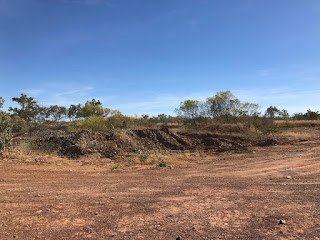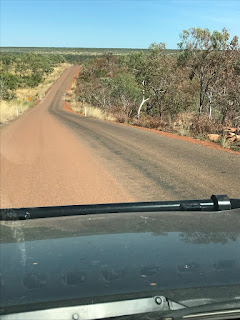Day 1 on the Gibb River Road 14 July 2017
 |
| Right at the very beginning of this particular adventure. Yippee! |
We hit the dirt 30 odd Ks after we turned off the Great Northern Hwy. And here we are - hooray! we made it to Derby in one piece.
Three days driving the GRR. 654Km (plus side trips) of mostly dirt, gravel, rock and corrugations. It's not for the faint hearted nor those concerned about getting totally covered in dust.
 |
| I prepared our pod for the long journey. I love duct tape! It saved a lot of food and avoided my nerves fraying |
We had prepared as much as we could, had excellent Trek notes with GPS coordinates, distances etc etc, spares galore, a swag of manuals, rolls and rolls of gaffer and duct tape, heaps of food, fuel and water PLUS the essential ingredient - we really wanted to do it! We weren't alone. The GRR attracts people for many reasons - to feel the magic of the Kimberley, get a big taste of the outback, but always to meet the challenge of driving one of Australia's iconic outback roads. It really is the best way to experience the Kimberley.
 |
| One of the many crossings. One of the groups had a drone and were filming there crossing - many times! I posted a video of our trip across the river on my Facebook page. Check out the escarpment in the background. Awesome isn't it!? |
There were lots of cars, camper trailers, caravans and even a couple of tractors pulling vans travelling in both directions. We also passed a few motor bikes and a couple of young cyclists going east. All power to them.
 |
| We came upon this gorgeous young man almost st the end of his tether. He and his mate are cycling around Australia. They had been riding 13 days on the GRR and he had just had enough. It was hot and the road was pretty rough. We stopped and chatted for a while to give him a bit of encouragement. He was a Melbourne boy and his mate was from the US. What an amazing journey they are on! And there we were tucked up in our comfortable aircon beast. All power to them!! |
The people? Older people than us as well as many families with young kids plus tourists in rentals or on tours in 4WD buses. For all that, we were miraculously alone at night in hidey holes along the route.
That first day was exciting, but a time also to adjust the body, eyes and neck muscles! to rough travel. Lindsay did a simply amazing job driving. I was the navigator, the eyes and ears, the supplier of encouragement, food and drink!
 |
| Huge monoliths like sphinx were our guardians much of the way. Hard to capture the magnitude of the scenery we were driving through, it is just so huge. The colour of the road changed under our wheels as we drove from grey to white, red, yellow and brown. |
We passed monumental ranges lined up like sphinx guarding the road and valleys. River and creek crossings too numerous to count, and dips and corrugations the entire way.
 |
| Oh no ... I feel a song coming on. Driving into the setting sun tra la la. .... A little while to go till dark but we were on a high after a fabulous and exciting day |
We stopped for the night well before dusk, cleaned up the van and fridge, which was a bit of a mess with lids off a few things and a bit of spillage (yogurt coated lots of things .. ugh) but .... easily wiped up. AND THEN we popped the cork on a bottle of champers!
 |
| Champers? But of course. We sat out and counted the stars that night. |
There we were slap bang in the middle of nowhere with nothing but the stars to watch us and the quiet mutterings of insects and birds to punctuate the magical silence - of the gravel pit!!
We were woken gently by the sun next morning with no time constraints on when we had to head off. Wonderful way to start the day! After stuffing ourselves with ham and eggs, we tied everything down and set off on our second day on the GRR.
 |
| Our camp spot first night. One of many gravel pits along the road. We saw and heard no one! Utter bliss |






















































